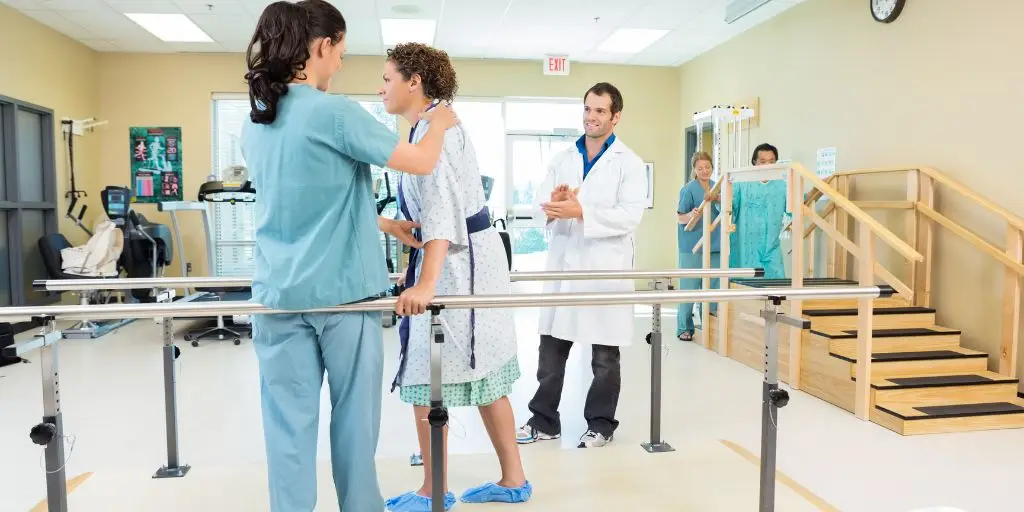Recovery from neck and back surgery is a complex process that is multi-dimensional and requires physical, emotional, and mental commitments. Everyone’s journey is different, but one important factor is the same for every patient: following medical advice is essential to a successful recovery. Rushing into regular activity too soon comes with serious consequences and could compromise the entire healing process. The most common reason for failure following spine surgery is doing too much, too soon, after the procedure.
Initial Post-Op Period
After surgery, patients may spend a few hours or a few days in the hospital, depending on the procedure performed, while they are monitored for their recovery from anesthesia, pain management, and proper wound observation and care. The length of the hospital stay can vary, depending on the surgery type and individual progress. Often times, patients can go home hours after their surgery.
Once discharged, patients continue their recovery at home. Initial post-op recovery occurs in the first two weeks after surgery. This includes a crucial period of limited but progressive activity while early healing begins. Mobilization during this period is essential to minimize medical complications such as pneumonia, urinary tract infections, and blood clots.
Intermediate Recovery
Intermediate recovery typically encompasses the period from 2 weeks to 6 weeks after surgery. If your surgeon prescribes specific exercises to do after spine surgery, follow their instructions implicitly. Certain exercises may be more effective for a faster recovery based on the type of procedure you had. For example, core exercises and hamstring stretches are often recommended after a microdiscectomy, but may be restricted following lumbar fusion surgeries.
Walking several times a day for progressively increasing distances is the single safest and most effective exercise recommendation. Your surgeon may also recommend during this timeframe that you begin to see a physical therapist who will work with you to design a safe, effective exercise program to restore normal daily function.
Full Recovery
It takes most patients 3 months or more to feel fully recovered from spinal fusion surgery. Recovery from a micro-discectomy or a cervical disc replacement can occur within a few days for a return to light-to-moderate physical activities, but return to unrestricted levels typically takes 6 to 8 weeks. Again, recovery times will vary depending on individual factors regarding your procedure, general medical condition, and it requires patient cooperation.
Roadmap to Recovery! Successful post-operative rehabilitation requires patience, commitment, and gradual progression. If back or neck pain is impacting your daily life, schedule an evaluation with the back experts at Texas Back Institute.
A Spine Surgery Expert Looks at Post-Operation Recovery

According to Dr. Jack Zigler of Texas Back Institute, there are several general guidelines patients should follow during the recovery process. Here are his top “Dos and Don’ts” essential to an optimum recovery after spinal surgery.
DO:
1. Follow Post-Op Instructions: Adhering to post-op instructions accelerates the healing process and plays a vital role in achieving the best possible outcome.
2. Take the Prescribed Amount of Pain Medication: Managing pain medication reduces the risk of dependency or overdosage. Balance pain medication with other recovery strategies, such as physical therapy, proper positioning, and rest. Stay ahead of the “pain curve” by taking medicine as prescribed, especially for the first few days after surgery.
3. Wear a Brace: If your doctor prescribes a brace to help stabilize your back or neck, it’s important to wear it. Limiting motion aids in the healing process and may decrease discomfort. Rigid braces are rarely used with modern-day implants, but a soft abdominal binder or soft collar may be prescribed to help soft tissue healing, as well as to remind you not to over-exert yourself once you are feeling better.
4. Stay Hydrated: Staying hydrated promotes nutrient flow that aids in joint and organ maintenance. Water intake is calculated by dividing body weight in half and then drinking that many ounces of water.
5. Ask for Help: Ask family for assistance with lifting or other mobility issues. Arrange for transportation to follow-up appointments until your doctor approves you to drive.

Don’t:
1. Overexert: Recovery is a gradual progression. If returning to normal activities comes too quickly, you run the risk of re-injury.
2. Bend, Lift, or Twist: Avoid bending at the level of surgery, lifting objects that are heavy, or twisting. These movements can interfere with the healing process. Follow all instructions regarding weight and movement restrictions.
3. Smoke or Drink: Refrain from alcohol while taking narcotic pain medication. Stop smoking. Tobacco use impacts healing because it restricts circulation and increases the risk of infection. It inhibits fusion healing as well as healing of implants to your bone. It may put you at risk for additional surgeries or delay your final healing.
4. Ignore Signs of Infection: Call your doctor if you are running a fever, have increased swelling or redness, or have drainage at the incision site.
5. Remain Immobile: Don’t overdo it, but don’t remain immobile for long periods of time. Too much bed rest or sitting for prolonged periods of time can interfere with blood flow and impede the healing process. Strike a balance between rest and gentle movement to prevent stiffness and muscle weakness.
Comparing Two Procedures
“When it comes to the post-operative recovery from spine surgery, there are many variables to consider,” according to Dr. Zigler. “These include the condition that led to the procedure, the type of surgical procedure used, along with the age and health of the patient and their occupation.
“For example, in the case of decompression surgery, which is surgery that relieves compression of the spinal cord or spinal nerves (also known as spinal stenosis), the compression could be due to a disc herniation or a narrowed spinal canal that is placing pressure on the spinal cord or nerve roots. These two conditions can be surgically treated with a discectomy (for the herniation) or a laminectomy (for treating a narrowed canal) which removes the back wall of the spinal canal to create more space for the spinal cord.”
After this decompression surgery, most patients can expect the following:
· To be in the recovery room for 1 to 1½ hours.
· The surgeon will contact your family while the patient is in recovery.
· After going to a hospital room, the patient will be able to use a PCA pump to get medication for pain control. This machine controls the amount of medication that can be received.
· Staff will usually get the patient out of bed the same day as the surgery.
· The hospital stay is generally hours to 1-2 days, depending on the extent of surgery and individual patient factors.
· A light brace or corset may be prescribed to restrict bending.
· The patient will be given any needed prescriptions and discharge instructions.
· A set of exercises that can be done at home may be provided.
· The patient will be able to ride in a car upon leaving the hospital. Airplane travel should be discussed with the surgeon.
· Physical therapy may be prescribed as early as after the first office visit with your doctor following surgery.
· Recovery from decompression surgery is usually relatively brief, but it varies greatly among patients.

“In contrast to decompression surgery, relieving facet joint pain requires a different approach to recovery from decompression surgery,” Dr. Zigler says. “Facet joints are paired spinal joints found on the posterior aspect of the spine. There is one joint on each side of the spine at each cervical, thoracic, and lumbar level. These joints, along with spinal discs, help provide support and mobility during movement and at each spinal vertebral level.
“As with other joints in the body, osteoarthritis (“wear and tear”) is the most common cause of this painful joint condition. Other conditions, such as rheumatoid arthritis, ankylosing spondylitis, trauma or whiplash, and stresses related to degenerative disc disease, scoliosis, or prior back surgery, can also contribute to spinal joint pain.
“If more conservative treatments such as physical therapy, stretching exercises, and injections do not relieve the pain from this condition, a rhizotomy, also called radiofrequency ablation (RFA) or neurotomy, can be performed in an attempt to provide longer-lasting pain relief ranging from months to years, typically 6 to 18 months.”
Recovery from this facet joint procedure involves the following:
· The patient is shifted to a recovery room for 15 minutes to an hour (if sedation was used), where his/her vital signs are continuously monitored. Depending on the area treated, a superficial burning pain with hypersensitivity, similar to a sunburn feeling, may be experienced. Sometimes a slight numbness of the skin over the same area may also be experienced.
· An ice pack may be used intermittently to numb the pain and reduce swelling at the injection site. Ice packs must be used for 15 to 20 minutes at a time, with a break of at least two hours in between, to avoid skin injury.
· Warm showers are preferred over baths for 1 to 2 days after the RFA procedure.
· Pain relief after this procedure is typically experienced 1 to 3 weeks after the injection. It is advised to rest for several days before returning to normal activities.
As these two examples suggest, just as every procedure is different, every recovery protocol is unique to that surgery and the health of the patient.
Optimal Recovery Is Likely
By following the surgeon’s post-operative instructions, there is an excellent possibility for optimal results. Other tips for an optimal recovery include getting a good night’s rest. Sleeping 8 hours a night is restorative and promotes healing. Maintaining a healthy weight and a nutritious diet will ensure healing benefits. Visualize yourself making a full recovery, moving freely, and returning to normal activity.
Most of all, keep a positive outlook. A large part of optimal recovery is self-care. Be kind to yourself. Healing is a gradual process.
If back pain is interfering with your quality of life, it might be time to talk to an expert at Texas Back Institute and set an appointment.


